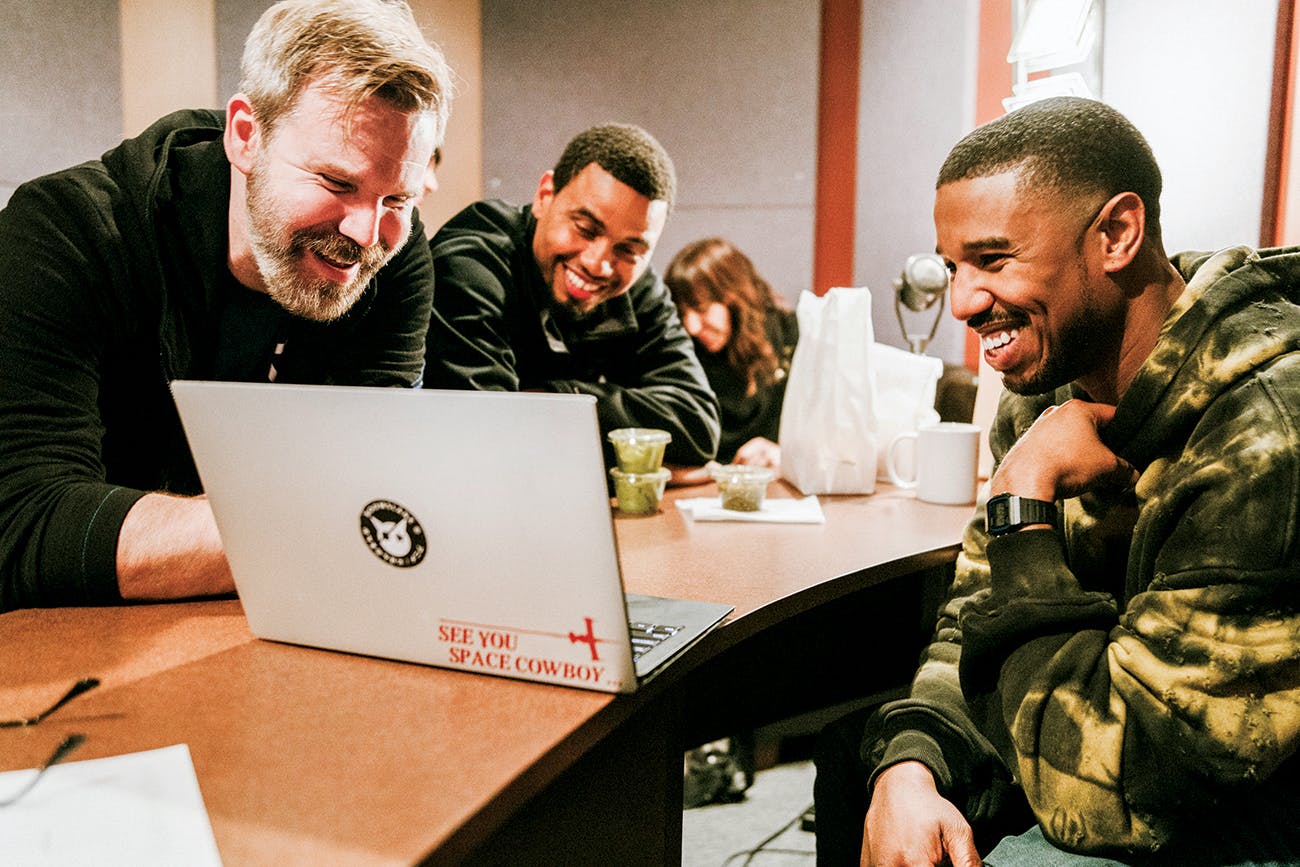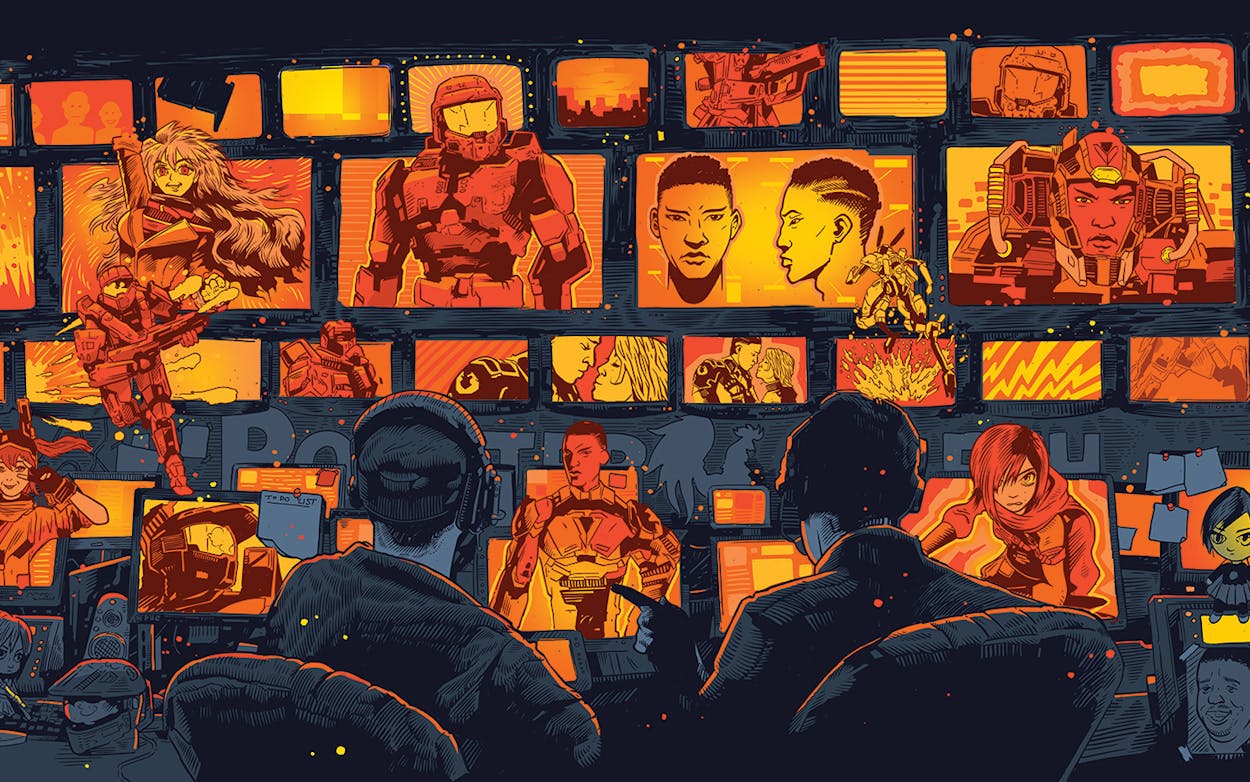Once a year, hundreds of thousands of fantasy, sci-fi, and superhero devotees trek to New York Comic Con. The festival’s hundreds of events take place in venues ranging from small, fluorescent-washed conference rooms to Madison Square Garden’s Hulu Theater, one of the city’s most hallowed stages. At last October’s convention, which drew a record 250,000 people, the cast of AMC’s The Walking Dead convened there; CBS hosted a discussion on the new season of Star Trek: Discovery; and Netflix previewed the third season of Daredevil. All three events filled the theater to capacity.
By contrast, there were hundreds of vacancies in the 5,600-seat auditorium when the Austin-based entertainment studio Rooster Teeth took the stage for the closing panel. Those who showed up, however, were committed. When the company’s head of animation, Gray G. Haddock, and his team announced a surprise preview from an upcoming episode of RWBY (pronounced “Ruby”), fans erupted. The animated fantasy web series, which follows the adventures of four young women charged with protecting their world, Remnant, from deadly creatures, has fueled Rooster Teeth’s rise since the show debuted, in 2013. Among the audience members were people who had been moved to tears days earlier, when, dressed in elaborate costumes, they met writers Kerry Shawcross and Miles Luna at a convention booth and presented their heroes with fan art pulled from RWBY backpacks.
Rooster Teeth has produced dozens of web series and podcasts, but RWBY is by far its biggest hit, averaging more than two million views per episode.
After the RWBY screening ended, Haddock announced that attendees would be the first people outside the company to preview Rooster Teeth’s newest 3-D animated series, Gen:Lock, months ahead of its January 2019 release. It’s the company’s most ambitious project yet, one that could put it on the path to becoming a Netflix for animation.
Gen:Lock is Rooster Teeth’s first major launch since its parent company, Fullscreen, was acquired by Warner Media (which counts HBO, Turner, Warner Bros., and DC Comics among its assets), in January 2018. The adult-focused series taps top-shelf voice talent: Black Panther’s Michael B. Jordan stars as the show’s protagonist, and Dakota Fanning, David Tennant, and Maisie Williams fill out the cast. The premise: in a near-future dystopia, stark cultural divisions have festered and grown into a global war where a team of humans wearing armored, superpowered “mecha” (robotic) battle suits fends off attacks from fighter jets and giant robots.
Gen:Lock is the studio’s chance to prove its mettle to its new parent company and land in the same league as top Warner properties—if not household names like Batman and Bugs Bunny, then reliable players like Aquaman and Teen Titans. They’ve made it to the big stage; now the future of Rooster Teeth hinges on filling the empty seats.

Level Up
Rooster Teeth dropped the moniker Drunk Gamers because the founders thought that no sponsors would sign on with a company that had the word “drunk” in the name.
Rooster Teeth was founded in 2003, in Austin, by Matt Hullum (now the company’s CEO), Burnie Burns (now chief creative officer), Geoff Ramsey, and Gus Sorola. It followed Drunk Gamers, a video-game-review website created by Burns, Ramsey, and Sorola. Their first hit was Red vs. Blue, a web series created by adding humorous commentary to gameplay of Xbox’s Halo. The show attracted an audience of gamers drawn to the mash-up of sitcom tropes and Halo’s gritty Blood Gulch setting.
Red vs. Blue, which, in its sixteenth season, is the longest-running episodic web series ever, predated shows on streaming giants like YouTube and carved its own path. It built an audience of paid subscribers and created vibrant, active web forums where its fans congregate. There, like-minded people can geek out over the trailer for the show’s new season or trade video game tips. Couples have met on the forums and gotten engaged. Fans post their own art and animation inspired by Rooster Teeth projects, a talent pipeline the studio uses to this day. “[With the community], it felt like we tapped into something no one had ever done before,” Hullum says. “It was like the sky was the limit.”
That community led the company to Monty Oum, a hotshot young animator they handpicked to work on Red vs. Blue’s eighth season in 2010, as the show advanced toward more sophisticated animation. Eager to encourage Oum, Rooster Teeth offered him complete creative freedom in 2012 when it greenlit RWBY, an anime-inspired show he had pitched.
At this point, Rooster Teeth was far from a fledgling operation. It had an international fan base, had launched a series of gaming-themed podcasts and talk shows, and had hosted an annual fan convention—RTX—that attracted thousands to Austin each year. It was quite the feat for a company that started in a three-bedroom house not even a decade earlier.
At the third annual RTX, in 2013, Rooster Teeth debuted the first two episodes of RWBY. After months of dissecting every frame of preview footage and art on the forums, fans arrived wearing elaborate homemade RWBY-inspired costumes. By the end of the screening, lines to greet Oum stretched to the back of the auditorium.
It offered the first glimpse of RWBY’s transformative effect on Rooster Teeth. When Oum—who ran the show until his sudden death in 2015 from an allergic reaction to medication—conceived the series, the company was headquartered out of a warehouse turned office space in South Austin, with a staff that numbered in the dozens. Two years later, thanks largely to RWBY’s success, it was bought by the California media company Fullscreen and was renting multiple stages and offices at Austin Studios, near the Mueller neighborhood. RWBY became the first American anime series to be exported to and translated for Japanese audiences. Rooster Teeth was also no longer simply an entertainment company: it was in the intellectual property business, creating original characters and worlds that could be licensed and adapted for other media. A RWBY video game was released in 2016, and Walmart sells RWBY merchandise.
That’s still a long way from the blockbuster franchises of other properties in its new company. “Warner Media is a supercharged IP-generation machine,” Hullum says. “We’re still a scrappy studio out here in Austin. We want to contribute and play at the level that makes us worthy of being in the Warner family.”
Rooster Teeth is already looking to capitalize on its new position. It’s actively planning a fresh slate of projects, anticipating that Gen:Lock’s success would mean more resources for additional shows in the near future. Gen:Lock needs to serve as a proof of concept that Rooster Teeth is capable of a slew of world-beating series.

Five weeks before the January 27 premiere of Gen:Lock, Haddock was scrambling to get home in time to help put his kids to bed before squeezing in a few more hours of work. He’s currently pulling double duty as the head of Rooster Teeth’s animation studio and the creative lead on Gen:Lock. “I’ve got a Google calendar that looks like the most complicated game of Tetris you’ve ever seen,” he says. “I’m having the time of my life.”
Haddock has been toiling away to create something that feels like a substantial leap from RWBY. Gen:Lock has a sense of humor, but its sensibility hews closer to American mainstream action drama than the anime-style sight gags and exaggerated expressions RWBY uses as comic relief. RWBY’s cast is largely composed of Austin thespians and Rooster Teeth employees, but Gen:Lock’s investment in stars like Jordan has raised the stakes. Says Hullum: “It has the most popular actor in America in it, so we have to be able to do something with the show.”
Still, Hullum wants the Rooster Teeth faithful to feel some ownership of the show, so RWBY vets are in the Gen:Lock cast alongside the superstars. That’s part of his strategy to ensure that Rooster Teeth fans become Gen:Lock fans, and vice versa. Most entertainment companies hope that audiences who come for one show will enjoy another, but their programming isn’t created with such a specific type of person in mind. Rooster Teeth, by contrast, wants to cater to the sci-fi and video game nerds who have sustained it from the beginning. “We intentionally try to cultivate a Rooster Teeth fan by [making connections between our shows],” Hullum says. “I doubt HBO spends a lot of time thinking, ‘We have to make sure that some of the actors in Ballers are also in Game of Thrones.’ ”
Haddock recognizes how important that sense of belonging to a community is to his audience, and he knows that being part of a larger corporation puts that connection at risk. “For me, the balancing act is protecting that culture and the alchemy that led to everything from Red vs. Blue to RWBY while we are still growing up as a company,” he says. “How do you protect that sense of play?”
The early reaction, even from the more skeptical fans, suggests that Gen:Lock pulls it off. The day after the series premiered, a fan on the Rooster Teeth subreddit summed up his reaction: “I was one of those people who was not excited for Gen:Lock. I thought the trailers were underwhelming . . . I was tired of seeing promotion for it. I just watched it. I am sold.”
If more Rooster Teeth fans feel the same, and the celebrity cast and mainstream sensibility bring in new viewers, then the next time Rooster Teeth presents at Madison Square Garden, the venue might well sell out. At that point, the company will be readying the launch of the next Gen:Lock–scale series and the one after that. Once you start playing on the biggest stages, the pressure to stay there never fades.
This article originally appeared in the March 2019 issue of Texas Monthly with the headline “Rooster Teeth: Unlocked.” Subscribe today.









